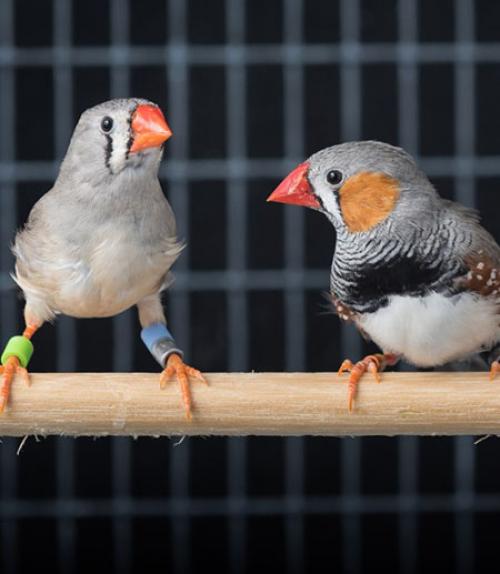Scientists rely on animal models to gain insight into how humans learn language, but it turns out that one of their favorite models, the zebra finch, has been entirely misunderstood.
New research reveals that these birds don’t simply learn their songs by imitating adults: They learn by watching their mothers’ reactions to their immature songs.
In “Female Social Feedback Reveals Non-Imitative Mechanisms of Vocal Learning in Zebra Finches,” published Jan. 31 in Current Biology, co-authors Michael Goldstein, associate professor of psychology, and doctoral candidate Samantha Carouso-Peck solve the mystery of why juvenile male zebra finches learn to sing better when females are around, even though the females don’t sing.
The researchers found that the adult females guide juveniles’ song development through specific interactions, similar to how human babies learn to talk. This study brings the number of species known to engage in socially guided vocal learning to four: zebra finches, humans, marmosets and cowbirds.
The researchers’ clue to the zebra finch mystery came when they considered that birds see the world at several times the “critical flicker fusion rate” of humans. Simply put, birds can perceive events that happen much too fast for a human to see, and most previous research on social learning has not taken into account such rapid “bird time,” in which tiny behaviors can have large social effects.
Using slowed-down video, the Cornell researchers were able to identify tiny movements, imperceptible to the human eye, made by the female zebra finches to encourage the baby songbirds. These included wing gestures and “fluff-ups,” an arousal behavior in which the bird fluffs up its feathers.
Researchers identified tiny movements, imperceptible to the human eye, made by female zebra finches to encourage baby songbirds. These included wing gestures and “fluff-ups,” seen here, an arousal behavior in which the bird fluffs up its feathers.
“Over time, the female guides the baby’s song toward her favorite version. There’s nothing imitative about it,” said Carouso-Peck.
The study included nine pairs of zebra finches, genetic brothers raised for the first 35 days by their respective parents. When they reached the age at which they begin to produce practice song (subsong), the siblings were split up, moved into individual soundproof containers and randomly assigned to one of two conditions: “contingent” or “yoked.”
Contingent birds were monitored by Carouso-Peck, and each time they sang in a way that matched their fathers’ song, she triggered a video playback of a female performing a fluff-up. The yoked bird saw the same fluff-up video at the same time as his contingent brother, but from his perspective the fluff-ups happened at random times unrelated to his song production.
A male zebra finch watches a video monitor displaying a female finch performing an arousal behavior called a “fluff-up. Credit: Michael Goldstein
After the birds’ songs “crystallized” into the final version, the researchers compared them to the songs of the juveniles’ fathers. They found that the birds in the contingent group learned significantly more accurate songs than their yoked brothers. Had the traditional model of song learning as pure imitation been correct, both birds would have learned the same song, because they had the same opportunity to memorize it early and practice it, according to Goldstein.
One possible reason for the zebra finch learning style, according to the researchers, is that because zebra finches use their songs to attract mates rather than defend territory, integrating female preferences into song is “a highly adaptive strategy for future reproductive success,” they wrote.
Researchers identified tiny movements, imperceptible to the human eye, made by female zebra finches to encourage baby songbirds. These included wing gestures and “fluff-ups,” seen here, an arousal behavior in which the bird fluffs up its feathers.
“Historically we’ve been studying these birds in isolation. That means we’ve been missing out on the entire social aspect of song learning,” Goldstein said.
Similarly, he said, most labs study human babies more or less in isolation.
“But what babies – zebra finch or human – are good at is exploiting social information in their environment,” Goldstein said. “These immature behaviors are not mindless practice and noise. Their function is to motivate the adults in the room to provide information.”
Zebra finches are widely used in research of vocal learning and production as well as research on Parkinson’s disease, autism, stuttering and genetic disorders of speech. “Incorporating social factors into studies of zebra finch learning will strengthen the species as a model system,” the paper’s authors write, “as it will uncover new possibilities for drawing parallels with human speech acquisition.”
The research was supported by the National Science Foundation and Cornell’s Institute for the Social Sciences.






